Boeing KC-135A 55-3121:
Her Amazing Story
by Jennings Heilig
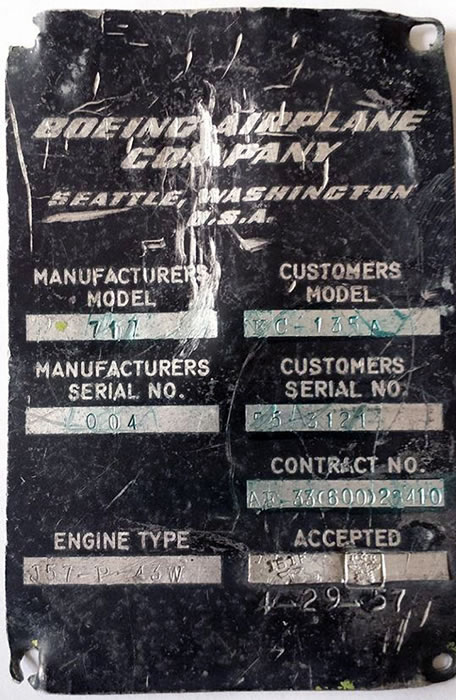

HyperScale is proudly supported by Squadron
Boeing KC-135A, Air Force serial number 55-3121 was the fourth of an eventual 820 KC-135 family members completed by Boeing at its Renton, Washington factory. She rolled out on 22 January 1957, and was the first KC-135A delivered directly to the U.S. Air Force rather than being retained by Boeing for flight-testing.

The aircraft was delivered on 29 April 1957, the Air Force immediately put it to work on its own Phase V test program, designated JKC-135A (“J” being the Mission Design Series – MDS – prefix for temporary test duties) to get the KC-135 ready for service with Strategic Air Command, participating in cold and warm weather and other testing around the world.

From 1957 to 1962 it was assigned to the Wright Air Development Center at Wright-Patterson AFB, Ohio, still engaged in various test programs. This was a colorful period for USAF aircraft, with day-glow markings on the nose, tail, and wing tips, and 55-3121 sported a stylish white crown over the cockpit to help keep it cool.

In the early 1950s, the Air Force had set up the BIG SAFARI program office with the goal of having an agile, lean organization that could engineer and modify (and de-modify) aircraft quickly and efficiently to meet rapidly changing requirements for reconnaissance platforms for all manner of collection needs. BIG SAFARI’s normal mode of operation was minimal paperwork, small numbers of people involved (and only with a “need to know”), minimal cost, and a small number of select contractors to perform the work. By today’s standards, this entire scheme would be unacceptable, but in the heady days of the Cold War, it was felt the benefits far outweighed the risks such a lean program presented.
On 20 April 1962 55-3121 was selected by the BIG SAFARI office at Wright-Patterson AFB for a new program called SPEED LIGHT. This program was involved in collecting photographic intelligence on above ground nuclear explosions (Nuclear Detonation Intelligence - NUDINT), primarily concerned with OPERATION DOMINIC American atmospheric nuclear tests near Christmas Island and Soviet above ground testing on the island of Novaya Zemlya in the Barents Sea. The aircraft was sent to General Dynamics in Fort Worth, Texas for conversion to the SPEED LIGHT ECHO configuration. She had a number of optically flat windows installed on either wide of the forward fuselage, with those on the left side being installed in her cargo door. Soviet tests ran from August through December of 1962, and US DOMINIC testing ran from April through October of that year.

In April and May of 1963 55-3121 was at the LTV facility at Majors Field in Greenville, Texas for conversion to the KC-135R special reconnaissance configuration, under the project name RIVET STAND. This designation has caused no end of confusion in the years since. The “R” suffix in this case long pre-dated and had nothing whatever to do with the much later KC-135R tanker re-engining program of the 1980s. The exact reason for its use is probably lost to history, but it may have been an attempt to signify “reconnaissance” without raising too many eyebrows by putting the “R” in front, possibly yielding a rather unwieldy “RKC-135A” moniker. The aircraft received a highly unusual array of ‘towel rail’ LORAN antennas along the upper fuselage that led to its being known as ‘the porcupine’. Mission tasking for this program came mainly from the Air Force Technical Applications Center (AFTAC) at Patrick AFB, Florida. The aircraft was assigned to the 34th Air Refueling Squadron at Offutt AFB, Nebraska during this period, and conducted reconnaissance operations worldwide. During this period she carried an onboard internal warning capability called GARLIC SALT. This consisted of intercept positions manned by enlisted linguists belonging to US Air Force Security Service (USAFSS), whose job it was to keep track of ‘bad guy’ voice communications to warn the aircraft’s front end crew of impending fighter or other reaction to their presence (as an aside, the RC-135 fleet continues to have this capability today).
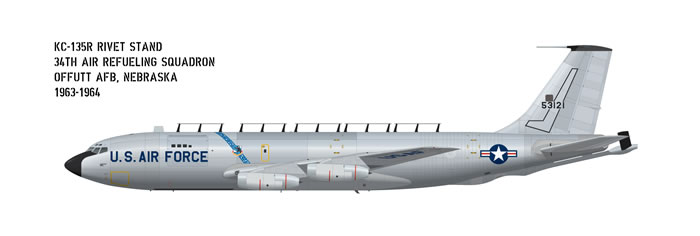
On 25 March 1965, 55-3121 was re-designated a JKC-135A and reassigned to the Aeronautical Systems Division of Air Force Systems Command at Wright-Patterson AFB, Ohio and used for various ASD-related test projects. She retained her previous external appearance, and between test program duties with ASD she was called upon to conduct AFTAC-related missions. When AFTAC had a requirement for a RIVET STAND/GARLIC SALT configured mission, 34th ARS crews flew the aircraft to either McClellan AFB, California or directly to RAF Upper Heyford where the stored modular mission equipment was reinstalled, and operational missions flown. The reverse then happened, and the aircraft returned to Wright-Patterson to resume her test duties. It was probably during this period that the aircraft received the extended vertical fin mod and powered rudder, along with a coat of Corroguard aluminized corrosion-resistant paint.
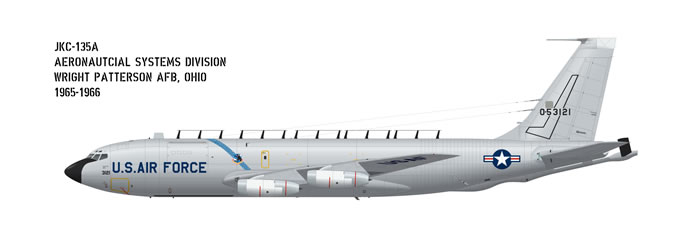
Beginning in July 1966, ‘121, still designated a JKC-135A, was reassigned to the 55th Strategic Reconnaissance Wing, and physically moved to the wing’s new facilities at Offutt AFB, Nebraska in November of that year. During this period she participated in the BURNING LIGHT task force, collecting NUDINT on French above ground nuclear tests in the Pacific, staging out of a very busy Hickam AFB, Hawaii along with a whole fleet of specialized C-135 variants observing various aspects of these tests. On 5 January 1967 55-3121 was once more re-designated a KC-135R while still with the 55th SRW.
Project BRIAR PATCH was a CIA funded program to collect “fine grain” electronic intelligence (ELINT) on Soviet ballistic missile early warning and space tracking radars being built in the northwestern part of the USSR in 1966-67. This type of ELINT equipment was termed Precision Parameter Measurement System (PPMS), and was an attempt to dissect the target radar signal down to the minutest parameter to ascertain its true capabilities. The initial BRIAR PATCH aircraft was 55-3121’s sister RIVET STAND KC-135R, 59-1465, which had been modified in early 1967. The life of 59-1465 as the BRIAR PATCH platform was short however, as she was lost in a fatal takeoff over-rotation accident at Offutt AFB in May of 1967, leaving the program with no collection platform. BIG SAFARI quickly identified 55-3121 as an appropriate replacement, and in July 1967 she was sent to Lockheed Aircraft Services in Ontario, California for conversion to the BRIAR PATCH configuration, still with the KC-135R designation. During the BRIAR PATCH conversion program the aircraft lost its familiar refueling boom, which was replaced by a large ‘A’ frame trapeze carrying an aerodynamic antenna body that was trailed behind the aircraft on a 1000’ steel cable to help eliminate electromagnetic interference in the target signal from the aircraft itself. Crews universally knew this device as the ‘blivet’, and it usually elicited a great deal of interest from intercepting Soviet fighters. At this time ‘121 received her first nose art (well, crew hatch art…), in the form of a flight suit clad rabbit holding a ‘blivet’, surrounded by barbed wire.
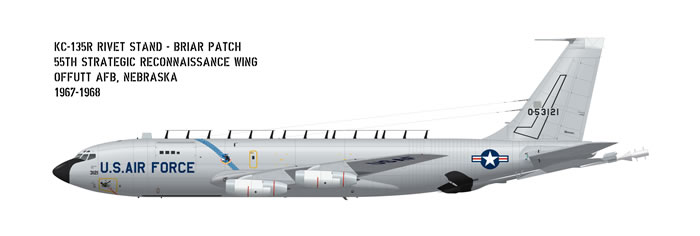
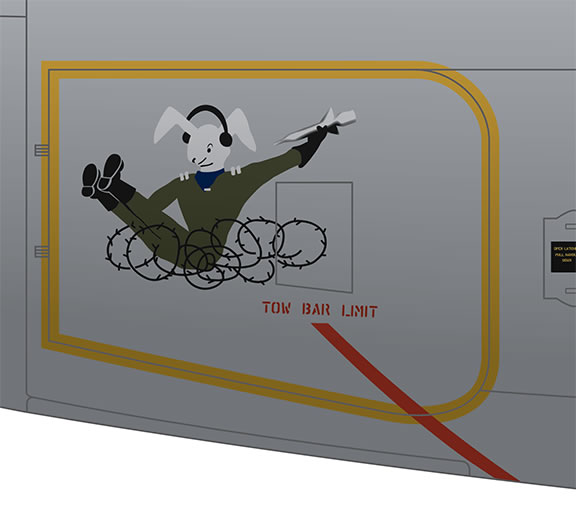

In May of 1968 55-3121 once again went to Lockheed Air Services in Ontario for conversion to the BUSTED JAW KC-135R configuration. Some sources indicate this configuration was a “fine-tuning” of the BRIAR PATCH collection configuration, but this remains unverified. What is known is that from September 1968 to March 1969 55-3121 was once again in residence at General Dynamics in Ft. Worth for modifications. Yet more mods were required to complete this upgrade, and in mid to late 1969 she went to LTV in Greenville and then on to Lockheed Air Services in Ontario for more work. During this period the aircraft received a radome under the forward fuselage that appears identical to that fitted to the RC-135S RIVET BALL (59-1491), which was active at the time. She also received large teardrop shaped ELINT antennas on the aft fuselage that later appeared on the RC-135S fleet, and the #2 ‘towel rail’ antenna on the spine was removed. Her crew entry door art was over painted, and new artwork featuring Snoopy holding a sword while riding a lion appeared on the nose forward of the door.
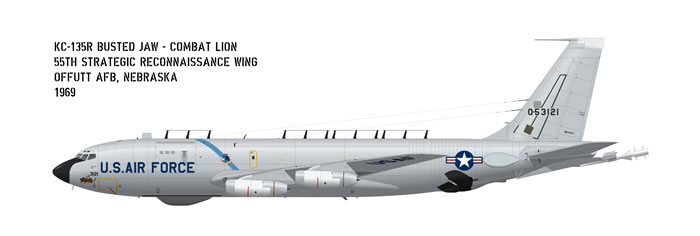
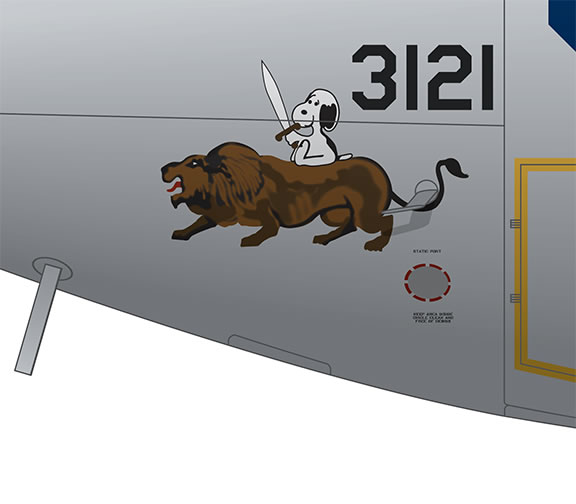
Five rather mysterious CIA-funded PPMS missions were flown by ‘121 from Kadena AB, Okinawa over the Gulf of Tonkin in October 1969 under the COMBAT LION program name while in the BUSTED JAW configuration. These appear to have been PPMS missions, but what the target could possibly have been is not known. Neither the Vietnamese nor the Chinese are known to have possessed any highly advanced radars that would have required such PPMS missions. This is a mystery that we will likely never know the answer to given its highly classified nature and the amount of time that has elapsed since.

Starting on 8 December 1969, 55-3121’s final reconnaissance configuration, this time with a change of designation to KC-135T, was performed by Lockheed Air Services at Ontario. As with the KC-135R MDS, this is not to be confused with the later KC-135T designation applied to converted KC-135Q tankers with CFM F108 engines in the 1980s and ‘90s. The program name was COBRA JAW, and the aircraft gained the ‘hog’ nose so commonly associated with the RC-135 family. The upper fuselage ‘towel rail’ antenna array was reduced to one, and a large angular blade antenna replaced the radome under the forward fuselage, with a (still unidentified) protrusion surrounded by a black ‘mask’ above it.

The specific target of the COBRA JAW was the Soviet equivalent to the west’s Ballistic Missile Early Warning System (BMEWS) radar network. The Soviets had installed a Dnestr-M radar (NATO designation HEN HOUSE) at Olenegorsk near Murmansk, and at Skrunda, near Riga in the Latvian SSR. The CIA was keen to learn as much about the specific capabilities of these radars in detecting potential incoming US ICBMs and SLBMs as possible, so the program was considered to be of high priority. Missions were flown in the Baltic Sea (against the Skrunda radar) and the Brents and Pechora Seas (against the Olenogorsk radar).
The aircraft’s first mission as COBRA JAW staged from RAF Mildenhall in the UK in September of 1970. For the first deployment, one of her crew painted the Ford Cobra Jet logo on the nose. On the second mission of the deployment, Soviet fighters as usual intercepted the aircraft. The USAFSS Russian linguists in the back end of ‘121 routinely monitored voice communications between Soviet fighters and their controllers, and on the second mission the MiG pilot was heard to say “The cobra has returned!” This was duly reported, and when news of this comment reached the brass at SAC headquarters, the order came down that the nose art was to be removed before the next mission.
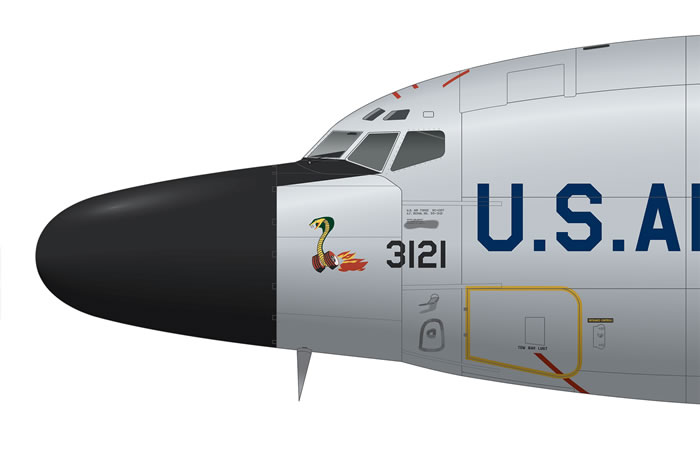
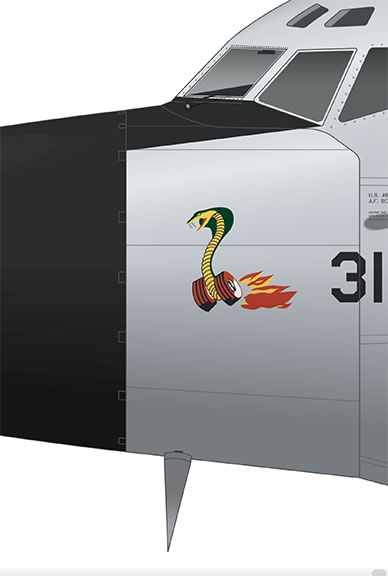
On 17 November 1970, 55-3121 was flying a routine (if such missions could ever be described as routine) COBRA JAW mission over the Pechora Sea near Vaygach Island. US reconnaissance aircraft were always very careful to maintain their distance from the sovereign airspace of the USSR, and carried two navigators who worked independently of each other to ensure that that was the case. ‘121 was operating in international airspace, but was nonetheless intercepted by MiG-17s based in the area. According to one crewmember, “The MiG-17s were so close that they were observed by the front end crew to be under the engine nacelles.” The fighter controller on the ground ordered the pilots to fire warning shots at the American “intruder”, and cannon fire erupted parallel to ‘121’s flight path. Her pilot confirmed with his navs that they were in fact in international airspace, and despite the threat, elected to continue the mission, turning in toward the Soviet mainland on his orbit. The Soviet pilot reported this to his controller, and tense moments ensued as the USAFSS linguists in back continued to monitor Soviet communications. Fortunately the Soviet fighters were eventually ordered to return to base and the COBRA JAW received no further threats. The close call on that mission, as well as the pending arrival of a new, dedicated PPMS platform in the guise of the RC-135U COMBAT SENT caused the CIA to pull the plug on the COBRA JAW program, and no further missions were flown.
Her PPMS mission over, 55-3121 had her specialized mission equipment removed beginning in June of 1971, including the A-frame for the ‘blivet’, and her designation was changed to RC-135T under the RIVET DANDY program name. She became a communications intelligence (COMINT) gathering platform, and she was used primarily on missions against Cuba from 1971 to mid-1973, while still assigned to the 55th Strategic Reconnaissance Wing at Offutt AFB.
In July 1973, ‘121’s days as an active reconnaissance-gathering platform came to an end. Her mission equipment was removed, although she retained her “hog” nose. She assumed the role of a trainer, allowing flight crews to maintain flying proficiency without jeopardizing valuable active reconnaissance assets. She bounced between a number of different units, mainly the 909th Air Refueling Squadron at Kadena AB, Okinawa, and by 1979 a brief stint with the 305th Air Refueling Wing at Grissom AFB, Indiana.
The 6th Strategic Wing at Eielson AFB, Alaska had been the sole operator of the RC-135S RIVET BALL/COBRA BALL platform since the early 1960s. In January 1969 the original RIVET BALL aircraft was lost in a landing accident on an icy runway at Shemya AFS, Alaska at the far western end of the Aleutians, fortunately without lost of life thanks to the incredible airmanship of her pilot, Maj. John Achor. RIVET BALL was replaced by a pair of thrust reverser equipped converted C-135Bs, also designated RC-135S, but called COBRA BALL. In December of 1979, 55-3121 was assigned to the 24th Strategic Reconnaissance Squadron at Eielson as the dedicated COBRA BALL trainer platform.
Since ‘121 still had her thirsty, underpowered, non-reversible J57 water burner engines, in early 1982 she was identified as a priority recipient of the TF33-PW-102 conversion then being carried out for the ANG’s KC-135E fleet. This involved a number of fixes and improvements, most notably the TF33 turbofans robbed from retired civilian 707s and 720s that were equipped with thrust reversers. She became only the second aircraft modified, which then gave her a configuration closer to that of the RC-135S fleet she was intended to stand in for during her training activities. She received a coat of smart new light grey paint, although many of the scars of her previous life as a reconnaissance platform were still visible on her skin. She had a fuel dump tube in place of her boom, and retained her ‘hog’ nose, but her entire cabin was empty.
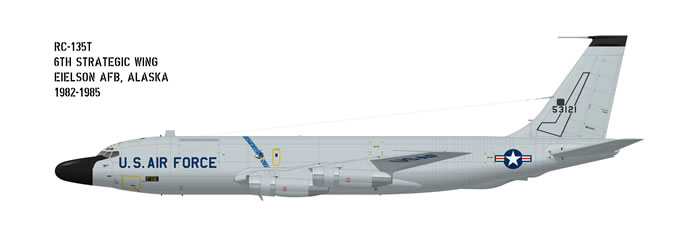
On 25 February 1985, a 6th SW command section crew, one of whom was taking his last flight with the wing before reassignment boarded ‘121 for a routine training flight. At the time, the then-new Microwave Landing System (MLS) was being tested by the USAF and the FAA in Alaska. ‘121 had had MLS equipment installed as part of the test program. The crew, without permission, flew down to Valdez, Alaska, which was one of the test sites for the MLS system. Despite deteriorating weather conditions, the crew practiced several MLS approaches with go-arounds. The airport at Valdez is situated in a box canyon, with high mountains all around. Its runway is far too short to accommodate a large aircraft like a ‘135, and the very steep MLS approach was designed only for short takeoff and landing aircraft such as the DeHavilland Canada DASH-7. On its third approach, ‘121 struck a mountain approximately 4 miles north of the airport, killing all aboard instantly. The crash was a sad and needless loss of human life and a very historic (arguably the most historic) KC-135 airframe that should have rightfully had a place in a museum someday.
At this point I would like to add a couple of comments regarding my family and personal connection to 55-3121. My uncle, Kay F. Heilig, spent a 20-year career in the USAF as an airborne Russian linguist with USAFSS. He was assigned to the 6985th Security Squadron at Eielson AFB, Alaska from 1966 to 1970, and to the 6949th Security Squadron at Offutt AFB, Nebraska from 1970 to 1972, retiring in 1975. He was involved in almost all of the early days of reconnaissance ‘135 activity, being the guy whose job it was to ensure that the front end crew knew who was about to come up to greet them (among other duties).
In the early 1960s, US reconnaissance activities staged from the UK were flown from RAF Upper Heyford, Oxfordshire. In the late 1960s operations were moved from Upper Heyford to RAF Mildenhall, Suffolk. MSgt Heilig was the NCO in charge of moving the USAFSS detachment to Mildenhall. After his move to Offutt, he continued on flying duties, and was involved in the 1970 COBRA JAW missions described above. He was the intercept operator who copied “The cobra has returned” that resulted in ‘121’s nose art being removed, and he was aboard the aircraft during the 17 September 1970 mission when the warning shots were fired that ended her career in PPMS collection.
Because my uncle always had such amazing war stories the few times I saw him as a child growing up in the 1960s and ‘70s, the RC-135 has always been my favorite airplane. I collected any scrap of material I could find on them - which wasn’t much in those days, and I drew pictures of them incessantly. When I joined Air Force ROTC in 1981, and after finding out the Air Force in its infinite wisdom wouldn’t allow me to fly, I requested an assignment as a Signals Intelligence Officer. After my technical training at Lowry AFB, Colorado and Goodfellow AFB, Texas, my first assignment was as a flight commander at the 6981st Electronic Security Squadron at Elmendorf AFB, Alaska in October of 1984. A large part of our job was to provide flight following for our RC-135 and other airborne reconnaissance aircraft operating around the Far Eastern part of the USSR.
Our operations floor had a secure teletype circuit (OPSCOMM) connected to our sister airborne unit at Eielson AFB. The circuit was rarely used, but still required a periodic comm check to be sure it was up and working. The machine was located out of the way behind several racks of electronics, and nobody paid much attention to it. One afternoon I happened to be passing by when the circuit chattered to life. All it said was “AN RC IS DOWN”. Well okay, but as far as we knew, there were no RC’s up anywhere in the entire area of our responsibility or that of units further south. All was quiet and calm. I typed “PLS CLARIFY” but received no reply. I tried a couple more times, again with no reply. I let my mission supervisor and my surveillance and warning supervisor know what I had seen, and discussed with them what we should do. It was our job to keep our folks out of harm’s way, and if something happened, to alert higher authorities up the chain of command. To be safe, I directed my S&W supe to start composing a CRITIC message. A CRITIC message is an electronic message that almost any entity in the US government or military can send out when something of critical national or international importance occurs. It wakes just about everyone who might be sleeping up, up to and often including the occupant of the White House. It’s a big deal…
While we were composing the potential CRITIC, I attempted to use our hopelessly unreliable secure voice line to call Eielson for more information. No one answered. A couple more tries, still no answer. We had no other indications from anywhere in the eastern part of the USSR that anything was amiss, so our confusion grew. Throwing caution to the wind, I left the secure area and went to one of the day shop offices and called Eielson on a non-secure line. A staff sergeant answered, and as soon as I told him who I was, he knew why I was calling. He told me that their COBRA BALL trainer had crashed somewhere in Alaska - it was 55-3121. Of course we then stood down from our CRITIC, and a potentially very bad situation was averted. As noted above however, three men lost their lives and we lost that historic aircraft.
Fast forward to 2018. There is a very active and very friendly and informative KC-135 group on Facebook to which I belong. A gentleman on the group had, as it turned out, been 55-3121’s crew chief in the early ‘80s at Eielson. One day as he was ascending the ladder through the cockpit access door under the nose, ‘121’s manufacturer’s data plate (attached to one of the bulkheads inside the access chute) snagged his fatigues and ripped them. He got mad and took out a screwdriver and pried the plate off the bulkhead and put it in his toolbox, and he had kept it all these years. After some good-natured discussion of whether I could get him to bequeath the data plate to me in his will, he offered to trade it to me for prints of my illustrations of all three of “his” ‘135s on which he had been crew chief. To say I was elated and eager is an understatement! The trade was made, and I am now the proud owner of the original Boeing factory data plate from 55-3121!
It gives me a thrill to hold a piece of history in my hand. The fact that I have such a strong family and personal relationship to that piece of history makes it all the more amazing to me, especially given that I never had any reason to believe that any part of the aircraft had survived the crash in 1985.
Text and Images Copyright ©
2018 by Jennings Heilig
Page Created 9 April, 2019
Last Updated
23 April, 2019
Back to Reference Library |
Home |
What's New |
Features |
Gallery |
Reviews |
Reference |
Forum |
Search